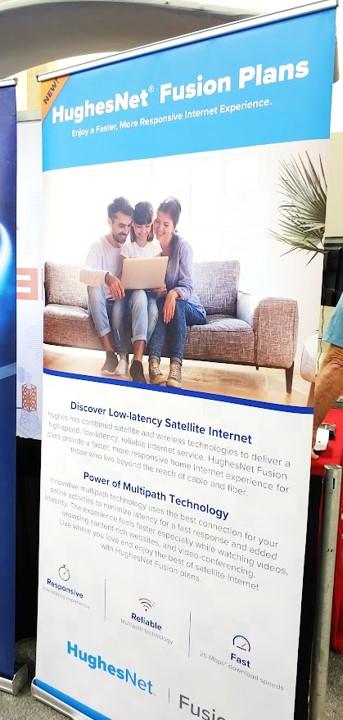Hughes has been offering geosynchronous (GEO) satellite-based internet service for a couple of decades. It has more than 1 million internet subscribers in the Americas. But now, it’s boosting its service with the help of some terrestrial wireless providers.
Jeff Moore, principal of Wave7 Research, noticed that Hughes was marketing HughesNet Fusion at the recent WISPA show in Louisville, Kentucky.
HughesNet Fusion is a new home internet offering that combines satellite and wireless technologies to improve latency. Plans are currently available in select areas, with expanded availability expected in the coming year.
Mark Wymer, senior vice president with Hughes, told Fierce that Hughes has partnered with some unnamed wireless carriers in North America for Fusion. The networks of those wireless carriers will help HughesNet cut down on the latency of customers’ internet connections.
The problem with GEO-based internet has always been the vast distances that traffic must travel – 23,000 miles from Earth to a satellite and back. This causes latency in the connection.
“We’ve taken the satellite capacity and married it with wireless capacity,” said Wymer. “The wireless eliminates that initial latency.”
He explained that when a user initiates a data session, the call for that data will simultaneously go to the satellite as well as to a nearby wireless network. Hughes refers to this as “multi-path” technology. Once the internet session begins, it will switch over entirely to the satellite connection.
“Satellite can put down a lot of bandwidth, but wireless augments,” said Wymer. “We don’t need a lot of wireless signal to carry the heavy bulk of data, just enough to get started and then transition to the satellite. It’s kind of a jumpstart. Once the session starts, if it’s a website and all the content has painted, then you’re over the satellite.”
Of course, there needs to be a terrestrial wireless service in the area of the customer. And there may not be. A lot of customers who are using HughesNet for their internet service are doing so because they’re in such remote areas that there are no other providers.
Wymer declined to name which wireless carriers Hughes is working with for Fusion. He said Hughes is also in discussions with additional wireless carriers.

He said that unlike the fixed wireless access (FWA) offerings of T-Mobile and Verizon, which rely on their 4G or 5G service, “we’re just using a little bit of that data.”
Fusion is officially available now, but it’s unclear how widely available it is. If a customer inquires about the service Hughes will check to see if it’s available in their area. The Fusion service is priced from $99 to $175 per month, depending on data amounts.
Wymer said HughesNet Fusion is a response to competitors such as SpaceX’s Starlink, which is offering home broadband internet via low-Earth-orbit (LEO) satellites.
Of Fusion, Wymer said, “This is really a cost-effective solution to address what’s happening in the LEO space. Due to their orbits, they’re able to address latency. We can address latency but also provide the large data requirements. In the LEO world they have smaller satellites. They don’t have the capacity we do.”
Hughes has two GEO satellites — Jupiter 1 and Jupiter 2 — and it plans to launch Jupiter 3 sometime later this year.
Wymer said Hughes hasn’t done much marketing of Fusion yet, but it plans to do advertising and marketing in conjunction with the launch of Jupiter 3.
Inspired by SD-WAN
Hughes got the idea for using wireless connections to augment its satellite service from some technology the company already uses for its enterprise customers.
RELATED: Hughes’ GEO satellites can do SD-WAN, too
Hughes has been providing software-defined wide area networking (SD-WAN) to enterprise customers for several years, using its GEO satellite connectivity. For instance, it connects about 2,000 gas stations in far-flung locations with SD-WAN.
Companies often have multiple connections — whether wireline, wireless or satellite — and SD-WAN software determines which connection is optimal at any given moment.
The idea for HughesNet Fusion’s “multi-path” connectivity to both a satellite and wireless provider is similar in concept to SD-WAN. “That was the inception,” said Wymer.